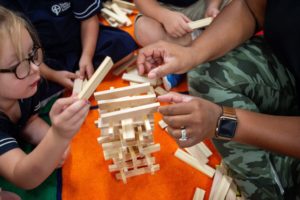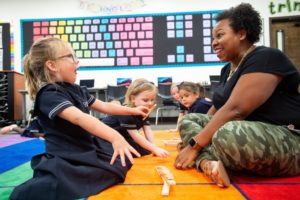**This post has been sponsored by Trinity Christian Academy to bring you this experience.**
Click around in the app store on any mobile device, and you can quickly become overwhelmed with all of the “educational” offerings available for youngsters. Electronic programs offer the promise of keeping your child’s mind engaged, and some do provide learning opportunities. However, these technology offerings alone are not sufficient to help children grow in areas that will help them be prepared for the future.
 One of the most important things you can do to keep a child engaged is to offer opportunities for exploration and discovery. The goal of exploration and discovery is to help young children develop and grow into lifelong learners. Many schools are using the subjects of science, technology, engineering and math, or STEM, to accomplish this goal. STEM is more than a simple acronym. Students deepen their learning by making connections to the material and applying concepts learned across subjects. STEM assignments are frequently project-based, allowing students to come up with solutions to real-world problems. Technology is one component of STEM education, considered a tool to enhance learning.
One of the most important things you can do to keep a child engaged is to offer opportunities for exploration and discovery. The goal of exploration and discovery is to help young children develop and grow into lifelong learners. Many schools are using the subjects of science, technology, engineering and math, or STEM, to accomplish this goal. STEM is more than a simple acronym. Students deepen their learning by making connections to the material and applying concepts learned across subjects. STEM assignments are frequently project-based, allowing students to come up with solutions to real-world problems. Technology is one component of STEM education, considered a tool to enhance learning.
STEM learning also helps students make gains in soft skills such as communication, collaboration, creativity and critical thinking, which are all considered crucial for 21st-century learners (Cohen et al., 2016). These skills are called the 4Cs of STEM. They must be learned and practiced often. It is never too early to begin to learn these skills, which are vital for children’s future success.
Here are some ideas for increasing exploration and discovery, using the 4Cs as a guide:
Collaboration
The home environment is an excellent place to teach children how to work together to accomplish a problem or complete a task. Children may learn to collaborate by participating in a fun task like stacking cups or blocks, or they may learn from a more purposeful task such as trying to invent a way to pick up toys in a more efficient manner. It may be helpful to model specific types of behavior you would expect to see or words you would expect to hear as children collaborate and come up with a solution.
Critical Thinking
 Challenge children to create something specific such as a car, a tower or an item of clothing, but with a twist: give them certain materials they have to use in their creation. Teach a child a simplified engineering design process, where they imagine the possibilities to solve a problem, come up with a plan, construct a model, evaluate and redesign as necessary. The steps required to repurpose materials or using them in unconventional ways helps children rethink how things work.
Challenge children to create something specific such as a car, a tower or an item of clothing, but with a twist: give them certain materials they have to use in their creation. Teach a child a simplified engineering design process, where they imagine the possibilities to solve a problem, come up with a plan, construct a model, evaluate and redesign as necessary. The steps required to repurpose materials or using them in unconventional ways helps children rethink how things work.
Creativity
Read books such as Not a Box and Ish to help children realize their creative potential. Encourage children to use apps or educational programs that encourage them to create something new, rather than solely consume technology. For example, write and record a song in Garage Band, pen a script for a movie and film it using iMovie or Apple Clips.
Communication
Verbally sharing about their creations allows children to practice communicating to an audience, even if it’s just sharing with you! Ask lots of questions to extend their learning. Sentences that begin with “Tell me why you…,” or “What were some of the challenges you faced when…” can provide valuable information about children’s thinking and may guide you as you choose topics or subjects to explore with your child.
Much learning takes place in the absence of a formal, structured curriculum (Papert, 1980). You can foster a culture of learning for children by offering them opportunities to discover and explore. When you present children with the tools and materials needed to construct their learning, you will also help them ask questions and seek answers about the world around them.
 Kelli Duhaney is the Lower School Technology Teacher at Trinity Christian Academy. She received her undergraduate and graduate degrees from Pepperdine University. She and her husband, Robert, have three children.
Kelli Duhaney is the Lower School Technology Teacher at Trinity Christian Academy. She received her undergraduate and graduate degrees from Pepperdine University. She and her husband, Robert, have three children.













